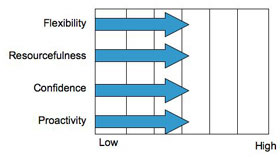There is a parable retold every year at the Passover table in Jewish homes around the world about freedom from slavery. It begins with the youngest child in the family asking “Why is this night different from all other nights?”. The answer in the text is directed to four different types of children: the wise one, the simple one, the wicked one, and the one who is yet too young to understand. Each of these children will interpret the telling differently, and it is recommended that the story be told with this in mind. In essence, the suggestion is to consider how the story will be heard and to deliver the message with this thought.
In No Problem I identify three distinct and unique outlooks that are applied to challenging moments, whether of a serious or not so serious consequence, and whether involving business or personal affairs. Like the four children around the Passover table, each of the three outlooks receives and processes information about a situation differently.
The Decision Making approach treats demands in a linear way, applying what is known to what must be determined in a systematic, structured way. In cognitive processing terms, decision making is a 1 to 1 to 1 sequence. When options exist and decision criteria are clear, this is the best approach to apply. When the decision matrix is built, the options are listed along one axis and are all compared to the set of criteria that are found on the other axis: 1 to 1 to 1.
The Problem Solving approach treats demands in an exploratory and dynamic way, applying knowable questions to determine or invent unknown solutions. In cognitive processing terms, this is a 1 to many sequence; we search or generate one time to develop and consider a number of alternatives.
The Dilemma-Based approach treats demands in a comparative, dialectical way, developing and maintaining constructive tension. In cognitive processing terms, we refer to this as a 2 x 2 operation. Essentially, 2 x 2 thinking involves consideration of high and low cases of two key factors affecting a situation, as in price and performance, or growth and profit. By looking at the four combined possible relationships (e.g. high-high), we are forced to ask a host of useful “what if” questions, leading to a novel or more accurate perspective.
The very best situation is where the circumstances match the approach. Great problem solvers operate in this way, efficient and linear, creative and analytic, or reflective and restrained, as necessary. The two questions to ask oneself are: do I recognize the difference between decisions, problems and dilemmas, and, am I capable of adjusting my approach.
Let’s take a look at several well-known situations to see how they have been framed and the consequences of misdiagnosis.
The US involvement in Iraq and its stated war on terror appears to be a problem solving frame applied to a dilemma. It is arguable (and many have) that there is no “solution” to the predicaments being faced. In the aftermath of horrible events such as 9/11, there is overwhelming frustration and desire to take decisive action. When facing a dilemma, every imposed “solution” risks causing undesirable and hard to anticipate secondary effects that in time make the situation even harder to manage.
The gradual decline of the US auto industry appears to be a problem solving demand situation treated as a dilemma. The determining forces of uncompetitive cost structures, attractive off-shore alternatives and inflexible design and manufacturing methods have held the big three auto makers in a declining limbo for too long. Courageous and creative action based in well-thought-out problem solving is arguably the antidote that has been absent from the industry’s response from the start.
The titles “Commission’ and “Inquiry” are often signs of decision making demand situations being avoided and treated as either a problem or dilemma. Governments and bodies like the UN engage in this kind of tactic too often as a way to sidestep tough actions that while needed may be unpopular with at least some constituents.
So, getting clear about what’s going on in a situation gives us the choice to match complexity and uncertainty with the most appropriate approach. As I say in the book, make decisions, solve problems and manage and exploit dilemmas.
 * Resourcefulness They have lots of methods, examples, friends, and experiences to draw on. The richer you’re kit bag, the more proficiencies you have, the better the results are likely to be.
* Resourcefulness They have lots of methods, examples, friends, and experiences to draw on. The richer you’re kit bag, the more proficiencies you have, the better the results are likely to be.